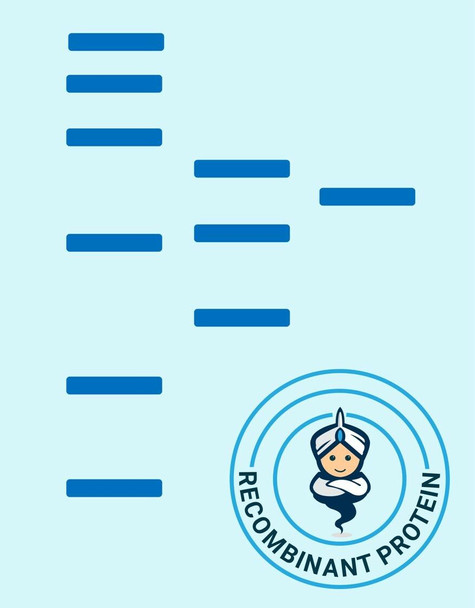Description
| Product Name: | Human PSMB2 Recombinant Protein |
| Product Code: | RPPB2205 |
| Size: | 10µg |
| Species: | Human |
| Target: | PSMB2 |
| Synonyms: | Proteasome subunit beta type-2, Macropain subunit C7-I, Multicatalytic endopeptidase complex subunit C7-I, Proteasome component C7-I, PSMB2, HC7-I. |
| Source: | Escherichia Coli |
| Physical Appearance: | Sterile Filtered colorless solution. |
| Formulation: | The PSMB2 solution (0.5mg/ml) contains 20mM Tris-HCl buffer (pH 8.0), 1mM DTT, 30% glycerol and 0.1M NaCl. |
| Stability: | Store at 4°C if entire vial will be used within 2-4 weeks. Store, frozen at -20°C for longer periods of time. For long term storage it is recommended to add a carrier protein (0.1% HSA or BSA).Avoid multiple freeze-thaw cycles. |
| Purity: | Greater than 90.0% as determined by SDS-PAGE. |
| Amino Acid Sequence: | MGSSHHHHHH SSGLVPRGSH MEYLIGIQGP DYVLVASDRV AASNIVQMKD DHDKMFKMSE KILLLCVGEA GDTVQFAEYI QKNVQLYKMR NGYELSPTAA ANFTRRNLAD CLRSRTPYHV NLLLAGYDEH EGPALYYMDY LAALAKAPFA AHGYGAFLTL SILDRYYTPT ISRERAVELL RKCLEELQKR FILNLPTFSV RIIDKNGIHD LDNISFPKQG S |
Proteasome subunit beta type-2 (PSMB2) belongs to the proteasome T1B family, which is a 20S core beta subunit. The proteasome is a multicatalytic proteinase complex with a highly ordered ring-shaped 20S core structure. Proteasomes are spread throughout eukaryotic cells at a high concentration and cleave peptides in an ATP/ubiquitin-dependent process in a non-lysosomal pathway. A crucial function of a modified proteasome, the immunoproteasome, is the processing of class I MHC peptides. PSMB2 is up-regulated in ovarian cancer cell lines.
PSMB2 Human Recombinant produced in E.coli is a single, non-glycosylated polypeptide chain containing 221 amino acids (1-201) and having a molecular mass of 24.9kDa.PSMB2 is fused to a 20 amino acid His-tag at N-terminus & purified by proprietary chromatographic techniques.
| UniProt Protein Function: | PSMB2: The proteasome is a multicatalytic proteinase complex which is characterized by its ability to cleave peptides with Arg, Phe, Tyr, Leu, and Glu adjacent to the leaving group at neutral or slightly basic pH. The proteasome has an ATP-dependent proteolytic activity. This subunit has a trypsin-like activity. Belongs to the peptidase T1B family. |
| UniProt Protein Details: | Protein type:EC 3.4.25.1; Cell cycle regulation; Proteasome complex; Protease Chromosomal Location of Human Ortholog: 1p34.2 Cellular Component: proteasome complex; nucleoplasm; proteasome core complex; membrane; cytosol; nucleus Molecular Function:threonine endopeptidase activity; protein binding Biological Process: positive regulation of ubiquitin-protein ligase activity during mitotic cell cycle; negative regulation of ubiquitin-protein ligase activity during mitotic cell cycle; protein polyubiquitination; viral reproduction; apoptosis; antigen processing and presentation of exogenous peptide antigen via MHC class I, TAP-dependent; response to organic nitrogen; DNA damage response, signal transduction by p53 class mediator resulting in cell cycle arrest; response to organic cyclic substance; regulation of apoptosis; antigen processing and presentation of peptide antigen via MHC class I; regulation of ubiquitin-protein ligase activity during mitotic cell cycle; anaphase-promoting complex-dependent proteasomal ubiquitin-dependent protein catabolic process; antigen processing and presentation of exogenous peptide antigen via MHC class I; gene expression; mitotic cell cycle; regulation of amino acid metabolic process; negative regulation of apoptosis; G1/S transition of mitotic cell cycle |
| NCBI Summary: | The proteasome is a multicatalytic proteinase complex with a highly ordered ring-shaped 20S core structure. The core structure is composed of 4 rings of 28 non-identical subunits; 2 rings are composed of 7 alpha subunits and 2 rings are composed of 7 beta subunits. Proteasomes are distributed throughout eukaryotic cells at a high concentration and cleave peptides in an ATP/ubiquitin-dependent process in a non-lysosomal pathway. An essential function of a modified proteasome, the immunoproteasome, is the processing of class I MHC peptides. This gene encodes a member of the proteasome B-type family, also known as the T1B family, that is a 20S core beta subunit. Multiple alternatively spliced transcript variants encoding distinct isoforms have been found for this gene. [provided by RefSeq, Dec 2010] |
| UniProt Code: | P49721 |
| NCBI GenInfo Identifier: | 1709762 |
| NCBI Gene ID: | 5690 |
| NCBI Accession: | P49721.1 |
| UniProt Secondary Accession: | P49721,P31145, Q9BWZ9, D3DPS0, |
| UniProt Related Accession: | P49721 |
| Molecular Weight: | 201 |
| NCBI Full Name: | Proteasome subunit beta type-2 |
| NCBI Synonym Full Names: | proteasome (prosome, macropain) subunit, beta type, 2 |
| NCBI Official Symbol: | PSMB2�� |
| NCBI Official Synonym Symbols: | HC7-I�� |
| NCBI Protein Information: | proteasome subunit beta type-2; macropain subunit C7-I; proteasome beta 2 subunit; proteasome component C7-I; proteasome subunit, beta type, 2; multicatalytic endopeptidase complex subunit C7-1; multicatalytic endopeptidase complex subunit C7-I |
| UniProt Protein Name: | Proteasome subunit beta type-2 |
| UniProt Synonym Protein Names: | Macropain subunit C7-I; Multicatalytic endopeptidase complex subunit C7-I; Proteasome component C7-I |
| Protein Family: | Proteasome |
| UniProt Gene Name: | PSMB2�� |
| UniProt Entry Name: | PSB2_HUMAN |







